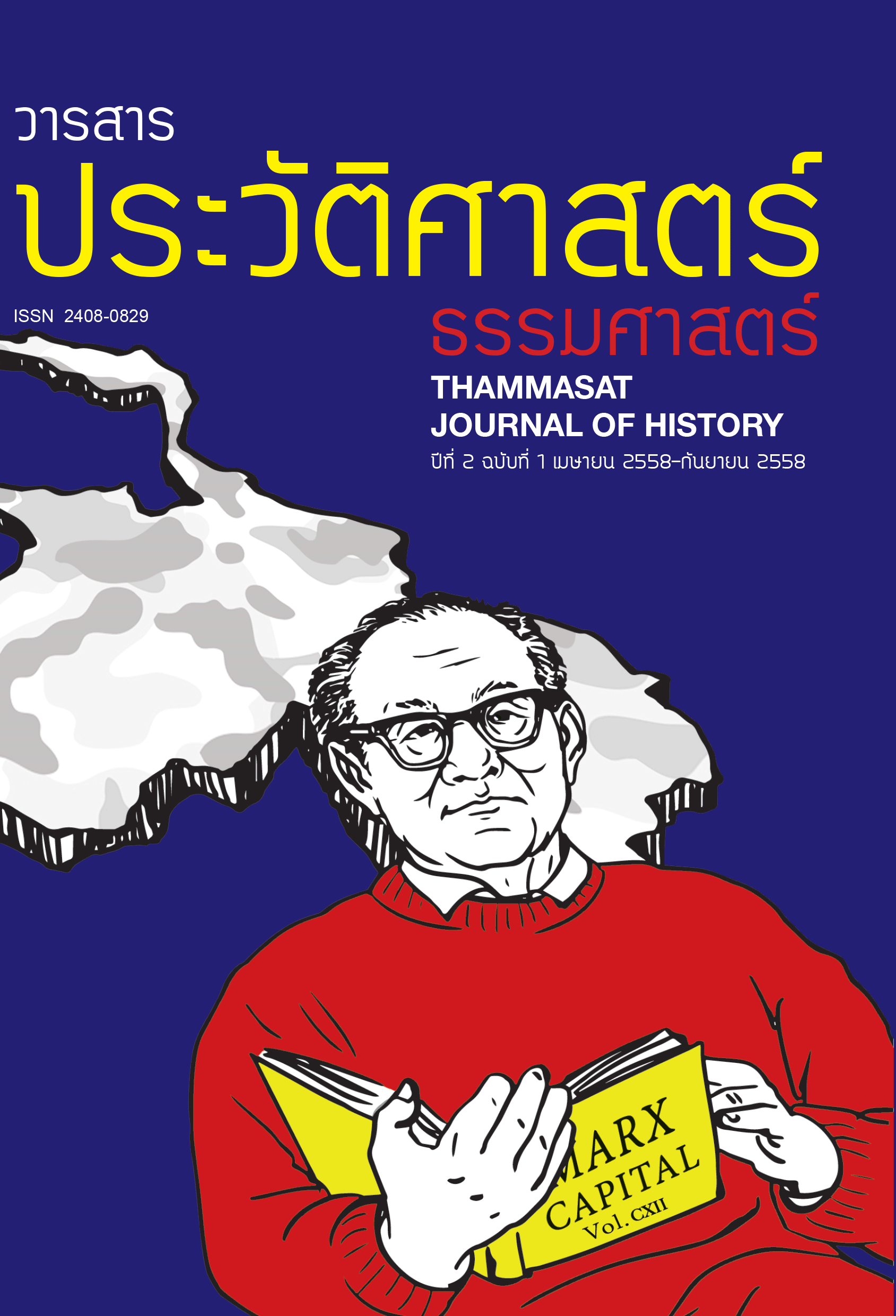Writing Rights into Thailand’s History with Photography
Main Article Content
บทคัดย่อ
ภาพถ่ายเป็นสื่อกลางที่ได้รับการยอมรับในการเผยแพร่ข้อมูลเกี่ยวกับความโหดร้ายและสร้างความตระหนักรู้เกี่ยวกับประเด็นด้านสิทธิมนุษยชน ตัวแสดงทางการเมืองและขบวนการเคลื่อนไหวทางสังคมยังใช้ภาพถ่ายในการสร้างภาพลักษณ์และจุดมุ่งหมายของตนอย่างแพร่หลายอีกด้วย ศักยภาพทางการเมืองของภาพถ่ายเชื่อมโยงอย่างใกล้ชิดกับบทบาทของการมองเห๋นในที่สาธารณะ ภาษาของภาพถ่ายเป็นภาษาเชิงสัญลักษณ์และภาษาเชิงข้อเท็จจรืงในเวลาเดียวกัน ทำให้ภาพถ่ายกลายเป็นวัตถุพยานที่สร้างปัญหาสำหรับการศึกษาประวัตศาสตร์ นอกจากนี้ภาพถ่ายยยัง เป็นได้ทั้งพื้นที่ของความทรงจำส่วนตัวและความทรงจำสาธารณะ เนื่องจากความหมายของภาพถ่ายขึ้นอยู่กับการตีความของผู้ชม หาได้ขึ้นอยู่กับเจตนาของผู้ถ่าย สิ่งที่ถูกถ่าย หรือผู้เผยแพร่ภาพถ่ายเหล่านั้นไม่ สื่อทัศน์ทำให้ผู้ชม
สามารถเข้าถึงเวลาและสถานที่ที่แตกต่างกันได้อย่างรวดเร็ว ทั้งยังสร้างความเป็นไปได้ในการเชื่อมต่อกับเหตุการณ์ต่าง ๆ ที่อาจขาดหายไปในบันทึกประวัติศาสตร์ โวหารทางสายตา อาทิ บทบาททางเพศสภาพ คู่ตรงข้ามระหว่างตัวเอกกับผู้ร้าย และสำนึกที่ผู้คนมีร่วมกัน ทำให้ภาพถ่ายกลายเป็นส่วนประกอบสำคัญในการสร้างประวัติศาสตร์ที่ครอบคลุม บทความชิ้นนี้ศึกษาการใช้ภาพถ่ายจากเหตุการณ์ทางการเมืองต่างๆ ในประวัติศาสตร์ไทยในการเขียนประวัติศาสตร์ภายใต้กรอบสิทธิมนุษยชน บทความเริ่มต้นจากช่วงกลางทศวรรษ 2510 เมื่อขบวนการเคลื่อนไหวทางสังคมในการเมืองระดับกว้างในประเทศไทยหันมาใช้ภาษาด้านสิทธิมนุษยชน รวมถึงเริ่มใช้ประโยชน์จากภาพถ่ายในการเขียนประวัติศาสตร์ของตนเองในขอบเขตที่กว้างขวางกว่าแต่ก่อน
Article Details
ลิขสิทธิ์บทความเป็นของผู้เขียนและสงวนสิทธิ์ตามกฎหมาย
ข้อคิดเห็นใดๆ ที่ปรากฏในวารสารนี้เป็นของผู้เขียน คณะกรรมการวารสาร ภาควิชาประวัติศาสตร์ฯ กองบรรณาธิการ ตลอดจนกรรมการกลั่นกรองประจำฉบับ ไม่จำเป็นต้องเห็นพ้องกับข้อคิดเห็นเหล่านั้น
References
Thammasat University Archive 14 October Foundation Thai Labour Museum
“Calm, Cool and Hopeful.” Bangkok Post, Sunday 10 October 1976.
Fa Diaw Kan, October-December, 2004 (2547).
Matichon Raiwan, 6 October 1996 (2539).
Sarakadee, October, 1996 (2539).
Suntiparp, special issue: Suntiparp Press, n. d.
Thai Rat, 20 October 1973.
Samut Phap Haeng Khwamsongcham Charuek Prawatsat 14 Tula Naiwara Khroprop 36 Pi 14 Tula [Album of Historical Recollections of 14 October at the 36 Anniversary of 14 October]: Munnithi 14 Tula.
The Memory of the Bloody Democracy (Chomna Prawatsat Chut Prachathippatai Lueat). Bangkok: Siam Publishing Ltd., 1975.
“Tamha Yatimit” [Searching for Relatives], TUA 2.4-1, 1996, Thammasat University Archives.
“Brasil Nunca Maís Digital”, Public Archive of the State of São Paulo, Brazil’s Federal Public Ministry, Armazem Memoria http://bnmdigital.mpf.mp.br/ - !/ (accessed June 15, 2015).
anon. Bueang Lang 6 Tula [Background to 6 October]: Naeoruam totan phadetkan haeng chat saharat amerika, 1978.
Azoulay, Ariella. The Civil Contract of Photography. New York: Zone Books, 2008.
Azoulay, Ariella. Civil Imagination: A Political Ontology of Photography. Translated by Louise Bethlehem. Brooklyn, N.Y.: Verso, 2012.
Butler, Judith. Precarious Life the Power of Mourning and Violence. London: Verso Books, 2004.
Chueathai, Somyot. Khadi Prawatsat 6 Tulakhom 2519 Khrai Khue Khatkon [Historic Case of 6 October, Who was the Assassin?]. 2 ed. Bangkok: 1988.
Eckel, Jan and Samuel Moyn. The Breakthrough: Human Rights in the 1970s. Pennsylvania Studies in Human Rights: Philadelphia, Pennsylvania: University of Pennsylvania Press, 2014.
Evans, Grant. “Immobile Memories: Statues in Thailand and Laos.” In Cultural Crisis and Social Memory: Modernity and Identity in Thailand and Laos, edited by Charles Keyes and Shigeharu Tanabe, 154-182, London: RoutledgeCurzon, 2002.
Gregory, Paul and Mark Harrison. “Allocation under Dictatorship: Research in Stalin’s Archives.” Journal of Economic Literature 43, no. 3 (2005): 721-761.
Haberkorn, Tyrell. “Tracing an Uneven History: Notes on Sources and Trajectories of Thai State Violence.” Asian Journal of Peacebuilding 1, no. 1 (2013): 109-116.
Haberkorn, Tyrell. “The Hidden Transcript of Amnesty: The 6 October 1976 Massacre and Coup in Thailand.” Critical Asian Studies, (2015): 1-25.
Isager, Lotte and Søren Ivarsson eds. Saying the Unsayable: Monarchy and Democracy in Thailand. Copenhagen: NIAS, 2010.
Kasetsiri, Charnvit and Petchlertanan, Thamrongsak, eds. Jak 14 Thung 6 Thula [from 14 to 6 October], 1998/2541.
Klima, Alan. The Funeral Casino : Meditation, Massacre, and Exchange with the Dead in Thailand. Princeton, N.J.: Princeton University Press, 2002.
Krittikarn, Sarun. “Entertainment Nationalism.” In Saying the Unsayable: Monarchy and Democracy in Thailand, edited by Lotte Isager and Søren Ivarsson, 61-87. Copenhagen: NIAS, 2010.
Lefort, Claude. “Politics and Human Rights.” In The Political Forms of Modern Society : Bureaucracy, Democracy, Totalitarianism, edited by John B. Thompson, 239-272. Cambridge, Mass.: MIT Press, 1986.
Mitchell, Don. “The Liberalization of Free Speech: Or, How Protest in Public Space is Silenced.” In Spaces of Contention: Spatialities and Social Movements, edited by Walter Nicholls, Justin Beaumont and Byron Miller, 47-67, Farnham: Ashgate, 2013.
Morris, Rosalind C. “Photography and the Power of Images in the History of Power.” In Photographies East: The Camera and its Histories in East and Southeast Asia, edited by Rosalind C. Morris, 121-160. Durham: Duke University Press, 2009.
Musikawong, Sudarat. “Mediating Memories of the 1970s in Thai Cultural Production.” Unpublished Doctoral Thesis (University of California, 2006).
Musikawong, Sudarat. “Art for October: Thai Cold War State Violence in Trauma Art.” Positions-East Asia Cultures Critique, 18/1 (2010): 19-50.
Musikawong, Sudarat. “Gendered Casualties: Memoirs in Activism and the Problem of epresenting Violence.” Meridians: Feminism, Race, Transnationalism 11, no. 2 (2013): 174-204.
Nora, Pierre. “Between Memory and History: Les Lieux De Mémoire.” Representations 26, no. 26 (1989): 7-24.
Reynolds, Craig J. Thai Radical Discourse: The Real Face of Thai Feudalism Today. Ithaca, N.Y.: Southeast Asia Program, Cornell University, 1987.
Sitthiket, Vasan. Tula Lai 1-31 Tulakom 2539 [Blue October 1-31]. Pathumthani University: Sunday Gallery, 1996.
Sontag, Susan. Regarding the Pain of Others . New York: Farrar, Straus and Giroux, 2003.
Tejapira, Kasian. “Signification of Democracy.” Thammasat Review 1, no. 1 (1996): 5-13.
The Ministry of Education, Thailand. “The Basic Education Core Curriculum.” Thailand, B.E. 2551 (A.D. 2008).
Tulathon, Chaitawat. Yam Yuk Ruk Samai: Chaloem Chalong 40 Pi 14 Tula [Reiterate the Past, Push Forward: Celebrating 40 Years 14 October]. Bangkok: Fong Tong Enterprise, 2013.
Weld, Kirsten. Paper Cadavers: The Archives of Dictatorship in Guatemala. Durham: Duke University Press, 2014.
Wetsuwan, Arun. Banthuek Phap Lae Hetkan Prawatsat 14 Tulakhom 2516 Lae 6 Tulakhom 2519 [Image Record and Historical Account of 14 October 1973 and 6 October 1976]. Bangkok: Arun Vithaya, 1998.
Winichakul, Thongchai. “”We do not Forget 6 October” – the 1996 Commemoration of the October 1976 Massacre in Bangkok.” In Workshop: “Imagining the Past, Remembering the Future”. Cebu, the Phillipines, 2001.
Winter, Jay. Remembering War : The Great War between Memory and History in the Twentieth Century. New Haven, CT, USA: Yale University Press, 2006.
Winter, Jay. Sites of Memory, Sites of Mourning: The Great War in European Cultural History. Cambridge: Cambridge University Press, 1998.
Yuval-Davis, Nira. “Gender and Nation.” Ethnic and Racial Studies 16, no. 4 (1993): 621-632.
Zarzycka, Marta. “The World Press Photo Contest and Visual Tropes.” Photographies 6, no. 1 (2013): 177-184.

